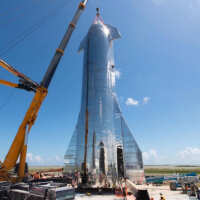Loopy Pro: Create music, your way.
What is Loopy Pro? — Loopy Pro is a powerful, flexible, and intuitive live looper, sampler, clip launcher and DAW for iPhone and iPad. At its core, it allows you to record and layer sounds in real-time to create complex musical arrangements. But it doesn’t stop there—Loopy Pro offers advanced tools to customize your workflow, build dynamic performance setups, and create a seamless connection between instruments, effects, and external gear.
Use it for live looping, sequencing, arranging, mixing, and much more. Whether you're a live performer, a producer, or just experimenting with sound, Loopy Pro helps you take control of your creative process.
Download on the App StoreLoopy Pro is your all-in-one musical toolkit. Try it for free today.
Want to hear the most incredible wind instrument ever invented?
Incredibly expressive and in many respects more like a human larynx than any real world instrument I've heard before.



Comments
If I had one, I'd need to run it through AutoTune to avoid that beginner violinist pitch problems. I know because I tried to play tunes on a slide whistle. But like the violin, with hundreds of hours of practice you develop the muscle memory to drop your fingers in the right spot and then add vibrato and glissandos. The Theramin has a similar issue... practice, practice, practice.
I just want to play so i'll probably keep working on GeoShred's keyboard. I suspect the sax app in GeoShred can do a lot of this for $10.
But as part of a live band or orchestra, are people lining up to watch a person play GeoShred? This instrument takes quite a bit of skill and it sounds like nothing else. And it looks amazing.
I appreciate your enthusiasm. Don't let me temper your passion for something innovative.
I'm just considering buying one to play and thinking there are other controllers I'd go for first but GeoShred meets my needs right now. If I had one of these I'd start with glissando turned off just to help master the fingering. I'm assuming the fingering chart might be different from a physical sax but it would makes sense to have that as a feature like the EWI's do.
The sound comes out of a speaker right (there's a synth in the system) and orchestras seem to avoid that with the exception of really modern works and then it's just another player adding new colors. Traditional audiences avoid these concerts and orchestras only do a few a year with new composers. The payroll is too steep to have empty seats. The audience programs the artist(s).
Live bands but mostly people will pay to see singer/dancers lip-sync with a group of dancers while the band is placed around the stage triggering loops. "Live music" still persists at open mics and smaller clubs focused on a genre or 3.
It looks like a soprano sax with a ribbon controller over the keys. I didn't notice if there's any physical indent to help align finger placement from power on.
This is not a digital instrument. It’s an acoustic instrument whic uses physical properties to make the sounds. See their detailed description on their web site under the “History” tab.
Or watch this remarkable video:
Sorry... after listening to the videos, I tuned out because at best it sounded like an out of tune soprano sax that can also make a few non-musical sounds.
But I see that it's a physical "ribbon strip" to replace the keypad holes on a conical sax. Changing the mouthpiece (the physical oscillator for the resonant tube) can allow it to function as a brass instrument too.
Exactly. Check out their videos. It’s quite novel sounding and can even emulate various animal calls quite convincingly. I suppose in some respects it’s like an extremely sophisticated bird call. Haha.
I used to teach small children to play clarinets in school bands and they could produce the most amazing "squawks and chirps" by not covering the wholes or providing proper air support for the column of air. The sounds we most definitely "fowl" but unintentionally funny. A damaged reed can also create new "under tones" that are outside the common scales of western music.
Clarinets are cylindrical and not conical so they are the only woodwind that overflows the same fingering by an octave and a 5th. Place a low G and add the overblow key and a D comes out. C major scale below maps to a G major scale up an octave. There are some odd fingerings to play that extra tritone region before the next note comes up on the fingering chart. I dint think there's another cylindrical vs conical distinction in the orchestra. Double reeds are also conical (Oboe, Bassoon, English Horn).
Those guys invented this thing? Or did Bart Hopkin get there first?
https://barthopkin.com/instrumentarium/moe/
No, these guys experienced what is called (in the world of patents and inventions) simultaneous invention, which they mentioned on their site (under the “History” tab):